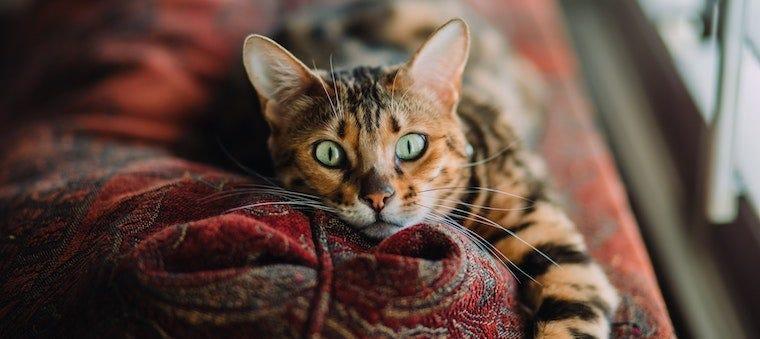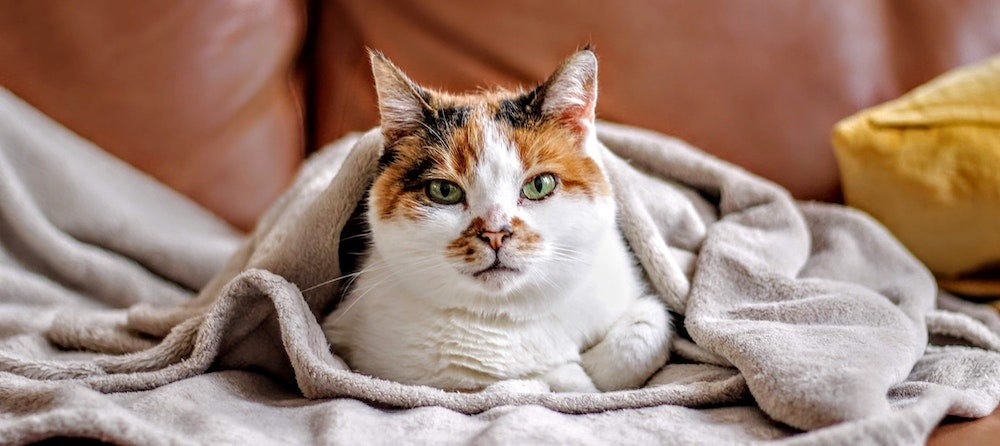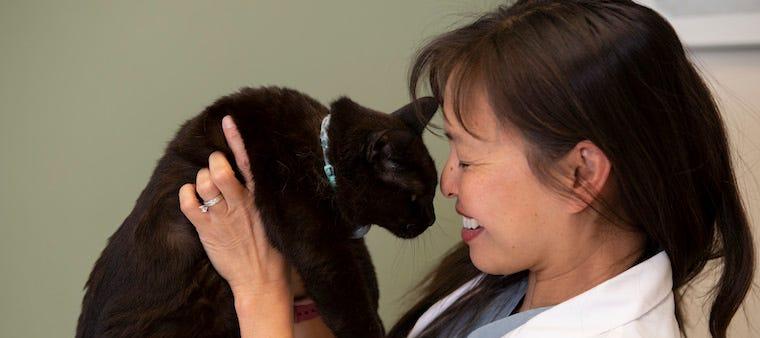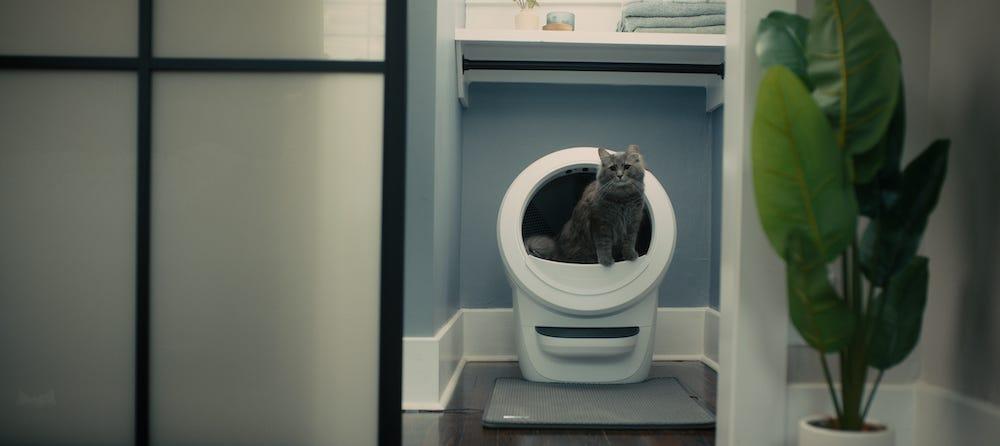Today we’re discussing stones in cats. Specifically, kidney stones in cats, ureteroliths, bladder stones in cats, and urethral stones in cats. Here’s what you need to know to keep your cat—and their urinary tract—safe.
Was your cat just diagnosed with one of these scary-sounding words? Cystic calculi, ureteroliths, uroliths, or urethral calculi. Sounds like a mouthful, but whenever you see the word uro or lith, your cat has a serious medical condition of their “plumbing!” Uro refers to the urinary system while lith refers to the Greek word for a calculus. Basically, it means that your cat has a stone.
Your cat’s urinary health
When it comes to your cat’s urinary health, you’ve heard me harp on the dangers of feline urethral obstruction (UO), urinary tract infections (UTIs), and feline lower urinary tract disease (FLUTD) before. That’s why, as an emergency veterinarian, I’m such a proponent of making sure your cat’s litter box is hygienic and clean. The dirtier the litter box, the less frequently your cat will visit the litter box. And the less your cat goes to the box, the more concentrated their urine becomes (e.g., more yellow and foul smelling too!).
Crystals in cat urine
If your cat happens to have crystals in their urine, those crystals also become more concentrated or potentially even congeal into a stone. This predisposes your cat to a life-threatening UO or “urinary blockage.” Cats can obstruct when grit, mucous plugs, crystals, red and white blood cell clumps, or even uroliths get stuck in the tip of their penis. Untreated, it can cause kidney failure, shock, and acute death!
Kidney stones in cats
Even more dangerous? Kidney stones. Like humans, cats (and dogs) can develop them too. Unfortunately, there’s no way to predict which cats will develop stones. (However, there may be an inherited component.) Some cats may not show any signs of kidney stones, and they may just show up randomly on X-rays of your cat. Other cats may show more vague signs of illness when they have kidney stones. This typically occurs when these stones obstruct the “plumbing” further down from the kidneys.
The two most common types of stones in cats are struvite or calcium oxalate stones, depending on the pH of your cat’s urine. Keep in mind that not all stones show up on X-rays. Struvite stones DO show up on X-rays and typically develop in alkaline to neutral pH urine. Calcium oxalate stones DO NOT show up on X-rays well, and develop in acidic to neutral pH urine. Often, cats that develop calcium stones have higher blood levels of calcium, and should have routine blood work to monitor for this.
Ureteroliths or ureteral stones in cats
Unfortunately, when cats get kidney stones, small parts of these stones can break off and get stuck in the ureters, the tubes connecting the kidneys to the bladder. These small stones are called ureteroliths, and can be potentially life-threatening. Personally, I hate ureteroliths, as the signs of a medical problem aren’t as obvious to a pet parent—or even to a veterinarian. Because these stones are “higher up” in the plumbing of the urinary system, ureteroliths won’t show up as signs of excessive licking or straining to urinate (as compared to lower in the plumbing of the urinary system, closer to the penis tip, where the signs are more obvious). Being that your cat has two tubes connecting two kidneys, it’s hard to tell if there’s a problem from ureteroliths until severe blockage is occurring… and often in both tubes/kidneys of your cat.
Bladder stones in cats
If the stones are in the bladder, these are called cystic calculi. Some cats have stones in their bladder without any consequence. However, sometimes the stones scrape the inside of the bladder lining, resulting in inflammation and secondary white and red blood cells accumulating in the bladder. This can then result in a urinary obstruction (UO). About 15-20% of cases with a urethral obstruction have a stone that caused the obstruction. This is why I always get X-rays on cats after I unblock them under sedation.
Urethral stones in cats
Sometimes kidney stones can travel from the kidney, down the ureter, into the bladder, and get stuck in the last part of the plumbing: the urethra (the tube going from the bladder to the exterior of the body, such as the penis tip). This is the most common condition I see affecting cat’s urinary tracts in the veterinary ER.
Symptoms to watch for
Depending on where the stone is stuck in your cat’s urinary system, signs of a problem include:
- Lethargy
- Hiding
- Acting painful
- Vomiting
- Not eating
- Blood in the urine
- Excessive grooming of the perineal region
- Abnormal urination
- Making multiple trips to the litter box
- Squatting to urinate in unusual places (e.g., like right in front of you, on a plastic bag, in a potted plant)
- Pain when you pick your cat up around the belly
- A distended stomach
- Halitosis (from kidney poisons building up and causing secondary ulcers in the mouth and gastrointestinal tract)
- Collapse
- Shock
- Weight loss (seen more with kidney stones)
- Death
How do you treat or manage stones in cats?
The best way to treat or manage kidney stones in cats, bladder stones in cats, or any urinary “plumbing” problem is by:
- Increasing water intake
- Discussing what to feed your cat with your veterinarian
- Doing routine blood work (especially as your cat approaches middle-age at 7-10 years)
- Keeping the litter box clean
Hydration
I’m an advocate of tempting your cat to drink as much water as possible, so I offer several water bowls or pet fountains throughout the house. Make sure to clean the bowls and refill them with filtered fresh water at least once a week. Next, make sure you offer your cat canned or wet food: This contains 60-70% water, and helps hydrate your cat more and flush out their urine so it’s more dilute. I actually train my cats to eat grueled-down canned food—I mix it with warm water so they drink even more.
Purina just released a product called Hydra Care, which is a nutrient-enriched water that promotes hydration in cats, as it contains nutritional osmolytes which help absorb water by the body. I haven’t tried this, but this may be an option to discuss with your veterinarian if your cat’s water balance is really delicate (e.g., stones, diabetes mellitus, hyperthyroidism, chronic kidney failure, etc.).
Dietary changes
Next, dietary changes. I don’t recommend changing the diet without consulting your veterinarian, as we need to find out which prescription diet is best for the crystals or stones that your cat may have. Thankfully, with certain prescription veterinary diets, struvite stones can be dissolved (e.g., Hill’s c/d, Purina UR, Royal Canin SO), but it typically takes several months to dissolve. Unfortunately, calcium oxalate stones can’t be dissolved with diet changes, but some prescription diets will help prevent further development of them.
NOTE: With any diet change, it should be transitioned very, very slowly to help your cat adapt to the new diet. Keep in mind that other foods or treats shouldn’t be fed once your cat is transitioned 100% to their new diet, as this negates the benefit!
Routine blood work
Doing routine blood work to monitor your cat’s calcium, salt balance, kidney function, and red and white blood cells, along with urine testing, is important as your cat ages. That’s because the sooner we identify an abnormality, the sooner we can treat it. For my cats, I do a physical examination and blood work once a year once my cat is over 7-10 years of age, and then twice a year as they approach 12-13 years of age. In fact, I’d rather you skip the vaccines (aside from the often legally-required one, rabies) as your cat ages to splurge on blood work instead!
Surgery or interventional radiology
If your cat has stones, surgery or interventional radiology may be an option. In some cases, surgery may be necessary to remove the stones from the bladder or to widen the diameter of the urethra (called a perineal urethrostomy). I only recommend this when a cat has had repeated problems or fails to respond to medical management. Unfortunately, less invasive measures like lithotripsy are not an option in cats as compared to humans or dogs, as the small stones can still result in obstruction lower down in the “plumbing” of the urinary system. Other options include a referral to a veterinary specialist, who may be able to do advanced techniques or re-routing of the urinary tubing to help treat uroliths (depending on the location).
A clean litter box
Finally, keep your cat safe from urinary problems by keeping the litter box clean. Personally, that’s why I love using a Litter Robot in my cat-friendly household. I always want to provide a fresh, clean bed of kitty litter each time my cat uses the litter box. And that’s why I specifically use the WiFi-enabled, self-cleaning Litter-Robot 3 Connect, as I can monitor how many times my cat is using her litter box.
Don’t despair if your cat was just diagnosed with crystals or stones. Oftentimes, the tips and tricks above will help dissolve or treat kidney stones in cats, bladder stones in cats, and more—and prevent an obstruction!
Photo by Caleb Woods on Unsplash







